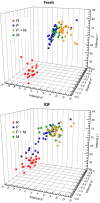Effect of precooking and polyphosphate treatment on the quality of microwave cooked catfish fillets
- PMID: 28572972
- PMCID: PMC5448386
- DOI: 10.1002/fsn3.465
Effect of precooking and polyphosphate treatment on the quality of microwave cooked catfish fillets
Abstract
In the U.S. market place, there are many examples of precooked poultry products designed to be reheated in a microwave oven and, to a lesser extent, fish products such as tilapia. However, few U.S. catfish products are designed to be microwave cooked or reheated. The first objective of this study was to examine the properties of microwave cooked raw frozen catfish fillets and oven precooked (to 62.8°C) frozen fillets and then reheated by microwave cooking. The second objective was to evaluate changes in properties as a consequence of treatment with a commercial polyphosphate blend (Individually Quick Frozen [IQF]). The sample analysis included weight loss, proximate content, color (CIE L*a*b*), pH, mechanical texture (hardness), and lipid peroxidation (TBARS) measurements. Frozen fillets which contained polyphosphate showed <4% moisture loss after microwave cooking, relative to a 12% moisture loss for fillets without polyphosphate. A large cooking loss of ~40% was observed for precooked fillets after microwave cooking, correlated with a higher percent moisture loss (11% and 13% for fillets with and without polyphosphate, respectively) to comparable samples that were not precooked. For both types of fillets, an increased amount of yellow color was observed for precooked fillets after microwave cooking, relative to comparable fillets that were not precooked. Fillet hardness determined by peak force revealed an overall harder texture (~1.1-1.8 times) for fillets without polyphosphate than fillets with polyphosphate. This study will be used to develop precooked catfish products that can be reheated in a microwave oven.
Keywords: Catfish; microwave; polyphosphate; precooked products; texture.
Figures








Similar articles
-
Comparison of sensory and instrumental methods for the analysis of texture of cooked individually quick frozen and fresh-frozen catfish fillets.Food Sci Nutr. 2018 Jul 27;6(6):1692-1705. doi: 10.1002/fsn3.737. eCollection 2018 Sep. Food Sci Nutr. 2018. PMID: 30258614 Free PMC article.
-
The wooden breast condition results in surface discoloration of cooked broiler pectoralis major.Poult Sci. 2018 Dec 1;97(12):4458-4461. doi: 10.3382/ps/pey284. Poult Sci. 2018. PMID: 29982812
-
Influence of Reheating Methods and Frozen Storage on Physicochemical Characteristics and Warmed-Over Flavor of Nutmeg Extract-Enriched Precooked Beef Meatballs.Antioxidants (Basel). 2020 Jul 27;9(8):670. doi: 10.3390/antiox9080670. Antioxidants (Basel). 2020. PMID: 32727026 Free PMC article.
-
Marination and packaging impact on textural properties of home-frozen broiler breast fillets.Poult Sci. 2013 Sep;92(9):2404-10. doi: 10.3382/ps.2012-02553. Poult Sci. 2013. PMID: 23960124
-
Comparisons of sensory descriptive flavor and texture profiles of cooked broiler breast fillets categorized by raw meat color lightness values.Poult Sci. 2010 May;89(5):1049-55. doi: 10.3382/ps.2009-00422. Poult Sci. 2010. PMID: 20371859
Cited by
-
Comparison of sensory and instrumental methods for the analysis of texture of cooked individually quick frozen and fresh-frozen catfish fillets.Food Sci Nutr. 2018 Jul 27;6(6):1692-1705. doi: 10.1002/fsn3.737. eCollection 2018 Sep. Food Sci Nutr. 2018. PMID: 30258614 Free PMC article.
-
Physicochemical Quality Retention during Cold Storage of Prepackaged Barramundi Meat Processed with a New Microwave-Assisted Induction Heating Technology.Foods. 2023 Aug 21;12(16):3140. doi: 10.3390/foods12163140. Foods. 2023. PMID: 37628139 Free PMC article.
-
Effect of Par Frying on Composition and Texture of Breaded and Battered Catfish.Foods. 2018 Mar 23;7(4):46. doi: 10.3390/foods7040046. Foods. 2018. PMID: 29570660 Free PMC article.
-
Use of Spectroscopic Techniques for a Rapid and Non-Destructive Monitoring of Thermal Treatments and Storage Time of Sous-Vide Cooked Cod Fillets.Sensors (Basel). 2020 Apr 23;20(8):2410. doi: 10.3390/s20082410. Sensors (Basel). 2020. PMID: 32340297 Free PMC article.
-
Microalgae as a potential raw material for plant-based seafood alternatives: A comprehensive review.Food Sci Nutr. 2024 Sep 23;12(11):8559-8593. doi: 10.1002/fsn3.4313. eCollection 2024 Nov. Food Sci Nutr. 2024. PMID: 39619996 Free PMC article. Review.
References
-
- Arannilewa, S. T. , Salawu, S. O. , Sorungbe, A. A. , & Ola‐Salawu, B. B. (2005). Effect of frozen period on the chemical, microbiological and sensory quality of frozen tilapia fish (Sarotherodun galiaenus). African Journal of Biotechnology, 4, 852–855. doi:10.5897/AJB2005.000‐3171 - DOI - PubMed
-
- Belongia, E. A. , MacDonald, K. L. , Parham, G. L. , White, K. E. , Korlath, J. A. , … Osterholm, M. T. (1991). An outbreak of Escherichia coli 0157:H7 colitis associated with consumption of precooked meat patties. Journal of Infectious Diseases, 164, 338–343. doi:10.1093/infdis/164.2.338 - DOI - PubMed
-
- Chang, K. L. B. , Chang, J. , Shiau, C. Y. , & Pan, B. S. (1998). Biochemical, microbiological, and sensory changes of sea bass (Lateolabrax japonicus) under partial freezing and refrigerated storage. Journal of Agriculture and Food Chemistry, 46, 682–686. doi:10.1021/jf970622c - DOI - PubMed
-
- Cross, G. A. , Fung, D. Y. C. , & Decareau, R. V. (1982). The effect of microwaves on nutrient value of foods. Critical reviews in food science and nutrition, 16, 355–381. doi:10.1080/10408398209527340 - DOI - PubMed
-
- Dyer, W. J. , Brockerhoff, H. , Hoyle, R. J. , & Fraser, D. I. (1964). Polyphosphate treatment of frozen cod. I. Protein extractability and lipid hydrolysis. Journal of the Fisheries Board of Canada, 21, 101–106. doi:10.1139/f64‐008 - DOI
LinkOut - more resources
Full Text Sources
Other Literature Sources

